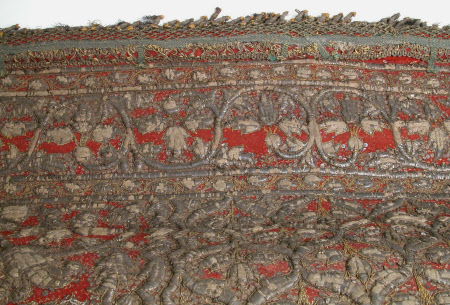Saddle cloth
Category
Textiles
Date
1700 - 1800
Materials
Canvas, velvet, wood, silk, net and silver gilt
Measurements
2570 mm (L); 1520 mm (W)
Order this imageCollection
Powis Castle and Garden, Powys
NT 1180740.1
Summary
Recent evidence suggests this may have been misidentified and is likely the palanquin cover imported by Robert Clive in 1774 and associated with 1180667. (July 2018 E.M.). Elephant saddle cloth with a heavy netted boble fringe in silver gilt thread, with wooden battens at regular intervals. Matching two horse saddles (T.12.2,3), ensuite. Velvet, encrusted with heavy silver gilt thread or wire embroidery raised on a core of thick yellow tusser silk ('zardozi' work), and spangles in a floral trellis pattern, with corner medallions and scroll borders. The lining of faded saffron yellow 'mashru' patterned with small blue, red and silver flower sprigs in a silver trellis; interlined with coarse canvas. Mughal style, 18th century. See 'Treasures from India' catalogue pg.108.
Provenance
Likely part of the palanquin (1180667) believed to have been abandoned at the battlefield at Plassey by Siraj ad-duula in 1757. Brought from Bengal by Robert Clive (1725-1774). Listed in 1774 inventory ‘A Package in a Matt containing the the Embrioder’d cover of the Palankeen 2 Cushions 2 Shawls and 1 Gauze Ditto. The Palankeen the large Bamboo Embroider’d…’ and in the 'Inventory of Indian Curiosities delivered 17 March 1775' as 'One Palankeen with a Bamboo and rich embroidered Furniture'. In 1761 George Smith Bradshaw charged Lord Clive for … ‘ a man taking the posts from the palanquin… 1[s] – 0 [d].’. Brought to Powis Castle from Walcot Hall in 1930. Accepted by HM Treasury on 21st March, 1963 in lieu of tax and conveyed to National Trust ownership on 29th November 1963.
